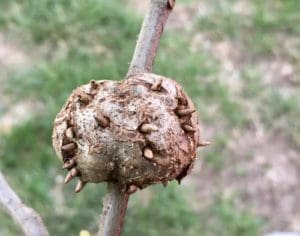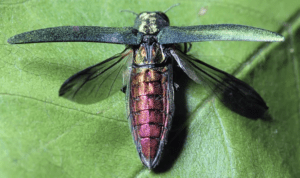Tree Troubles?
Is your tree starting to die? There are several potential culprits that could be affecting your tree in the St. Louis area. In this article, we will cover common threats to trees in urban landscapes.
Oak Gall Wasp
In recent times, the number one tree killer in the Maryland Heights area is the oak gall wasp. They attack pin oak trees, and form golf ball-sized growths (galls) which suffocate the vascular system of the tree and cause branches to die as they become infected. We highly recommend working with a professional tree service company to keep your pin oak trees in good shape.


Emerald Ash Borer
Another common pest in St. Louis is the emerald ash borer. These exotic, invasive, wood-boring insect infests and kills native North American ash trees, both in forests and urban settings. These borers suffocate the vascular system similarly to oak galls, but unlike the oak galls the damage from ash borers is more difficult to see. Symptoms include canopy dieback, as well as D shaped exit holes in the bark near the base of the tree.
Oak Wilt
Oak wilt is a serious disease that occurs primarily in trees in the red oak family, such as the pin oak, northern red oak, and shingle oak. These trees will die within weeks to months after contracting the disease! The fungus is primarily spread through root graft transmission which means one tree endangers the nearby trees.
Girdling Roots
Trees are often planted too deep, with their root flares completely covered by dirt or mulch. This suffocates the roots and often causes some roots to seek air. The tree roots will come up to the surface and wrap around the root flare which will accidentally strangle the tree. As the tree grows, the root will further tighten to only make it worse for the tree. We see this issue, particularly on maples and sweetgum trees in St. Louis.
Armillaria Root Rot
This is a serious disease caused by a fungus that lays dormant in the soil, and once a tree has received too much water the fungus will start to harm the root system. This fungus can kill a tree in a matter of weeks, and the damage will be done before any warning signs are spotted.
Weed Kill
Do you spray weed killer around the base of your tree so that area doesn’t need to be mowed? Or perhaps the lawn care company you use is doing so. Well, it can affect your trees so proceed with caution!
Drought
Drought stress is common amongst many types of trees and can lead to other problems which will speed the decline of your tree.
Removing Live Limbs
Often requested by customers who are concerned about appearance or shade, this is generally not a healthy practice as it puts stress on your tree. Removing limbs can actually put your house or car at more risk because the lower limbs can act as a safety net for the higher limbs.
Improper Mulching
Many people mound mulch against the trunk of their trees. The mulch absorbs water from rainfall and remains moist, and this moisture will cause rot and decay in the bark layer of the tree. This process harms the cambium layer that is responsible for the uptake and transpiration of water and nutrients throughout the tree.
Nutrient Deficiencies
Trees need chlorophyll to survive, and in our area, the soil is lacking a crucial element in the process of producing chlorophyll – iron. When trees are lacking iron their leaves will turn yellow which is a sure sign of distress. If left unattended chlorosis will weaken your tree and even if it doesn’t kill the tree, it will leave the door open for a pest or disease to come in and finish the job.
Construction Damage
Construction can at times be unavoidable, but sometimes they will have to cut through important roots. However, a more common danger associated with construction damage is soil compaction that is caused by heavy machinery. When soils are compact, it doesn’t leave room for air to get to the root system, which suffocates the roots and can cause a tree to decline over a 3-10 year period.
Lightning
Lightning is obviously a candidate qualified to kill your tree. Lightning can cause the sap inside the tree to turn to steam, which can cause the tree to explode. If it doesn’t explode, and instead the bark flies off, then the lightning has traveled through the vascular system and scorched it.
Chlorosis
Chlorosis is a very common tree ailment and one of the greatest causes of tree decline in the St. Louis area. Discoloration due to chlorosis occurs between the veins while the vibrant green hue will remain near the veins. Typically, other kinds of leaf discolorations happen uniformly throughout the leaf. This particular pattern of discoloration serves as the biggest hint that your tree has chlorosis.
Contact Jackson Tree Service
That’s a long list of reasons why your tree could be dying, right? Well, save the hassle of self-diagnosing and finding the right solution to treat or either prevent these situations by calling Jackson Tree Service. If you reside in St. Louis, Jackson Tree Service is the top choice when it comes to tree care. We are an experienced, local business that specializes in tree health care. Contact us today!

